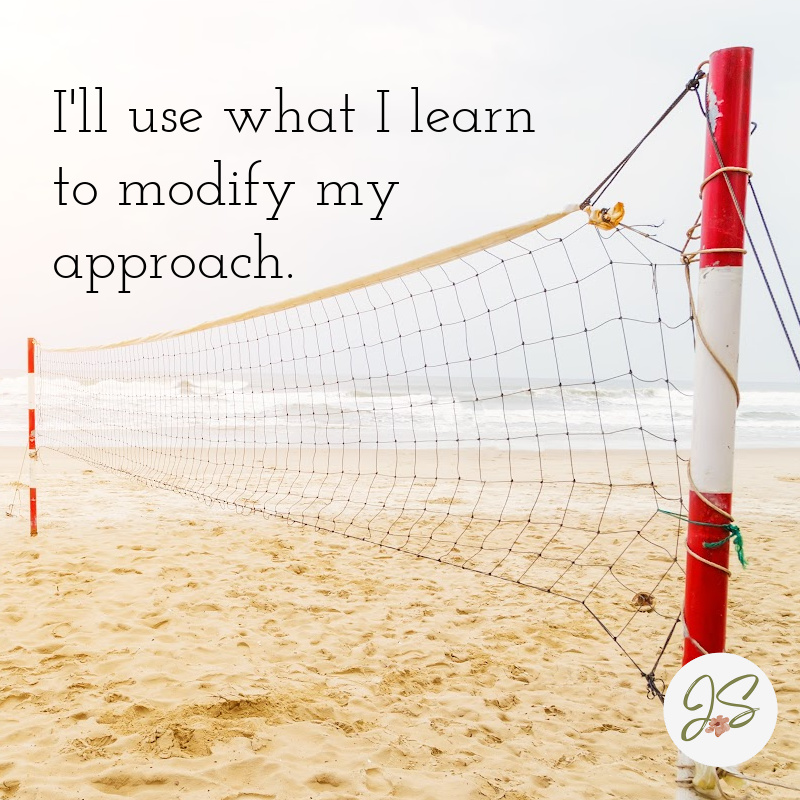Jeff and I met playing volleyball. But we’re both short, so we’re not known for spiking the ball over the net. The player who spikes it usually gets credit for a point, but it’s actually the bump and the set that win the game. Bump—set—spike. If you’re going to connect, you have to know how to play through the turning point.
Playing Well With Others
Conversations begin with someone bumping the ball. Sometimes it’s bumped to a place where the next player has to stretch, dive, or sacrifice to connect. Injuries happen. Players with awareness of others on the court know how to position the ball so the next player can more easily connect.
The question bumps the conversation into the air. In the right place, the next player has the chance to set it into a sweet spot for connection to the other side. A smooth series of back and forth conversations makes for exhilarating play. So at what point does play fall apart or leave someone on the ground, limping away, or wondering what happened?
When we pose a question to other people, it’s our job to bump it in a way they can respond. Too hard, too off center, or too high, and we’re setting them up for uncertainty and imbalance. They may head to the bench.
When someone receives our bump, it’s also our job to observe how they receive and play it. How did our delivery impact their balance and their continued engagement in the game? If they lose the ball or end up on their face, we might want to consider our form. Seeing how our approach impacts the next person, usually the person across from us, is the turning point.
The turning point may happen face to face around a table, across the café counter while ordering, over a social media comment string, at a church leaders’ meeting, over the phone or over texting. We bump the ball and the listener sets it back to us. What do we learn about the other person in that moment in their attempt to receive and set the ball? What we learn and what we do with what we learn determine if we complete the connection.
Awareness in the Turning Point
Have you ever started a conversation by bumping a question to someone else who responded in an unexpected way? Maybe they seemed awkward, uncomfortable, sad, or defensive. We have the potential for connection — with strangers, family, or friends — others. At this point, we can promote smoother connection or set up the other player to look like the loser.
What will my pride choose?
If I ask a question and the person responds in shock, awkwardness, pain, or embarrassment, I need to think about how I bumped the ball to them. I also need to use what I observe to inform my next steps. I don’t want to repeat the same move and set them up for further failure or injury. If I’m attentive to the other player, I’ll use what I learn to modify my approach.
“Do nothing from selfish ambition or conceit, but in humility count others more significant than yourselves.” (Philippians 2:3)
The Turning Point With Others
The learning point is the turning point. Will we keep bumping the way we like to because we like to? Or will we yield to what we observe and adapt our approach in others-centered humility?
Softer next time. A little lower. Easier pace. Not so close to the center.
After you read this, you’ll take the court with someone else. You’ll attempt to connect. It may be on social media, at the gym, or at your family dinner table. One of you will bump the ball to the other. In a moment of opportunity, to be observant of the other, a turning point will happen. Connection will succeed or fail based on what happens with the opportunity for awareness and learning. Will we fixate on our own style, or will we focus on the person receiving the bump?
It’s been a long time since Jeff and I played volleyball. But we live in the court of connection with each other and with others daily. Who are you connecting with? If we want to help others engage and connect, approach matters. We’ll know it when were’ at the turning point.
10 Questions to Ask When You Ask a Question
- Does the listener lean in or away?
- What happens to eye contact or body language?
- How does the facial expression change?
- What does the tone of response tell you?
- If there’s laughter, what kind of laughter?
- How do you feel while waiting? What does that say?
- Does the response come in a single word, statement, or question?
- How does the response you get set up the response you give?
- Was there an increase or decrease in comfort level between you?
- What grows between you? Understanding or confusion?


